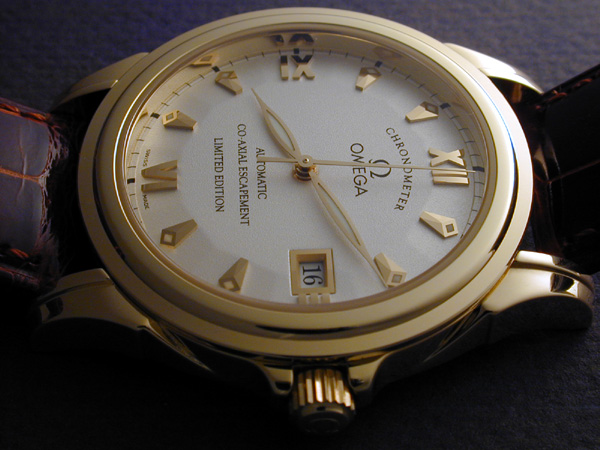

Among the more anticipated releases at the Basel fair in 1999 was by Omega of a new DeVille model. While the DeVille in recent years has taken a back seat to the Speedmaster, Seamaster, and Constellation, it has always been an understated, but elegant, classic design. But what made this watch so special was the inclusion of an entirely new escapement - the Co-Axial escapement as invented by Englishman Dr. George Daniels. In addition, the watch would be released in a limited edition of just over 2000 total (1000 in yellow gold/white dial, 1000 in red gold/blue dial, 109 in platinum/copper dial, and a small number (~20) in a skeletonized version.)
The Daniel's escapement has been under development for over 20 years by Dr. Daniels, who has been trying to solve some of the fundamental issues regarding the reliability and accuracy of mechanical watches. That Omega, the most recognized brand of the SMH group after Swatch, worked to bring this to market first yields some clue as to the potential importance of this development. One could argue that only SMH had pockets deep enough to move forward with the tooling for the Co-Axial escapement; however, the fact that this tooling has been developed means that we can look forward to regular use of this escapement as SMH recovers the development costs.
An interview with Jean-Claude Biver of SMH indicates that the Co-Axial escapement will be showing up in several other brands in the near future.
This was one watch which I kind of fell into. I told myself some time ago that while I would never actively seek one of these timepieces, if I saw one unspoken for in a shop, I would buy it. That day came in November of 1999 in downtown Seattle. They even had my choice of white dial and blue dial.
I chose the white dial because (1) it was a more classic look, and (2) I have too many dark faced watches. Nevertheless, the blue dial version is stunning in person as well.
The DeVille comes in a pretty standard looking box - a white paper covered outer box and a black leather inner box with beige felt interior. The watch is not fastened around a pillow, but instead is secured flat via a felt-covered clip in a padded area. On the inside top of the packing is a pocket with a special hand-signed certificate and booklet on the Co-Axial escapement, along with the more normal warranty and operating manual information. The actual COSC certificate is not included. :-(

The watch actually does not look like any of the other models in the current DeVille line. Rather, it recalls the look of the famous Omega Constellations of the 1950's. The pie-pan dial, the large applied markers, and the shaped lugs all were characteristics shared by the Constellation of yesteryear.
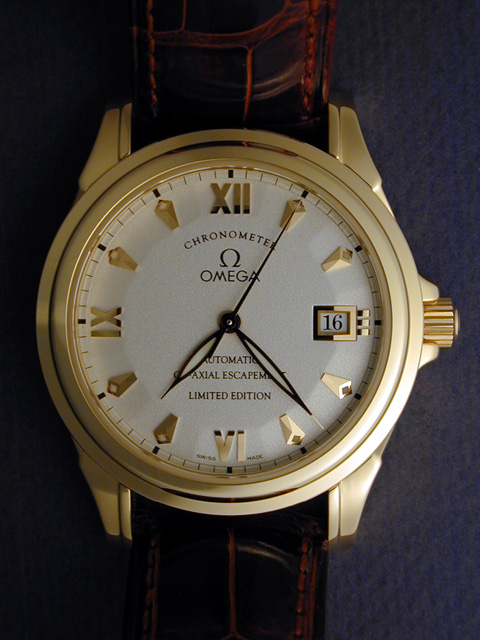
The overall image and heft of the watch is that it is a substantial piece. With a basic case diameter of 38mm (not including the crown, crown protectors, and lugs), the watch itself is sized fairly normal by today's standards, but lugs and crown protectors add a lot of bulk to the appearance of the watch. Furthermore, this watch is somewhat thicker than usual for a simple calendar with a movement height of 4.05mm: the watch itself measures 9mm (in comparison, it is about 12% thicker than the regular Omega DeVille automatic using a similar movement). These dimensions yield a total watch weight of about 80g including clasp and strap.
The initial impressions upon seeing it in person was that this
was a truly stunning piece, with a high polish everywhere.
All of the elements of the dial, case, crown, and strap are complementary
and in balance. As the first gold dress watch of my collection,
I'm happy to say that it would fill in that role handily even
without the Co-Axial escapement.
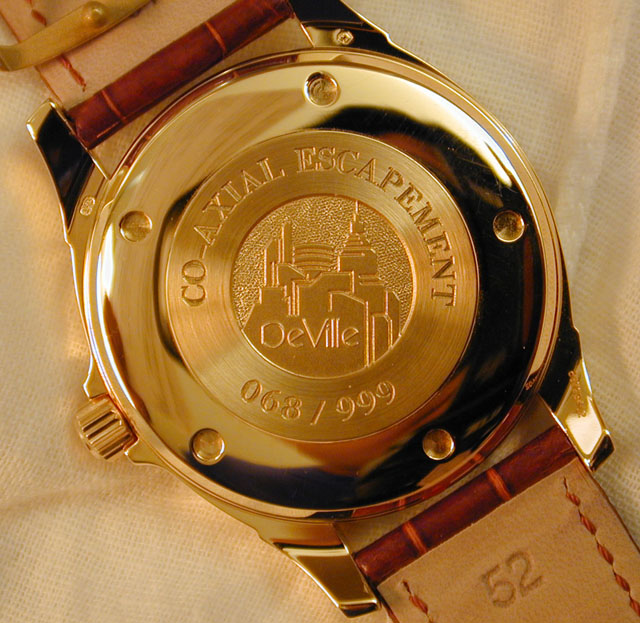
Inside the beautifully engraved (but solid, alas) back of the watch is an Omega Caliber 2500. This appears to be a development of the Omega 1120 with the addition of the Co-Axial escapement and Free Sprung balance. The Omega 1120 itself is a modification of the ETA 2892A2 - modified with a unique autowinding bridge to yield a smaller ball-bearing rotor hub. Unfortunately, I do not have a scan of the movement itself, but as part of the literature which comes with the watch is a booklet is a description of the Co-Axial escapement. (Note the following couple of pages describe the theory behind the Co-Axial escapement, and can be skipped.)
 The Daniels Co-Axial escapement is touted as
the first practical advancement in escapement design since the
design of the lever (or anchor) escapement by Thomas Mudge in
the 1700s, and was designed to overcome some of the weakness inherent
in the lever escapement. Specifically, the traditional lever
escapement uses each pallet jewel to both lock the escapement
AND transmit force from the wheel train to the balance (to keep
the balance going). Part of its design is that the "impulse
surface" of the jewel must slide along the escapement tooth
to transmit the force, as illustrated in the picture to the left.
The issue here is that the the sliding surfaces must be lubricated
sufficiently to allow this to take place smoothly. As oil
ages and becomes more viscous, the ability of the force to be
transmitted efficiently is reduced, which leads to lower balance
amplitudes and poorer performance. (This photo is referenced
from Walt's Horologium Article, "The
Anchor Escapement". I highly
recommend this article to understand the principle of operation
of the lever escapement. For a quick reference, here's a
link
to Walt's page of a sequence of 6 pictures
which shows the lever escapement in action.)
The Daniels Co-Axial escapement is touted as
the first practical advancement in escapement design since the
design of the lever (or anchor) escapement by Thomas Mudge in
the 1700s, and was designed to overcome some of the weakness inherent
in the lever escapement. Specifically, the traditional lever
escapement uses each pallet jewel to both lock the escapement
AND transmit force from the wheel train to the balance (to keep
the balance going). Part of its design is that the "impulse
surface" of the jewel must slide along the escapement tooth
to transmit the force, as illustrated in the picture to the left.
The issue here is that the the sliding surfaces must be lubricated
sufficiently to allow this to take place smoothly. As oil
ages and becomes more viscous, the ability of the force to be
transmitted efficiently is reduced, which leads to lower balance
amplitudes and poorer performance. (This photo is referenced
from Walt's Horologium Article, "The
Anchor Escapement". I highly
recommend this article to understand the principle of operation
of the lever escapement. For a quick reference, here's a
link
to Walt's page of a sequence of 6 pictures
which shows the lever escapement in action.)
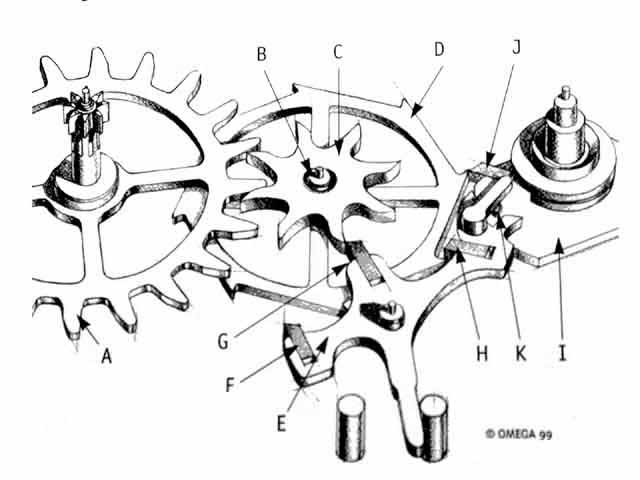
The Co-Axial Escapement, as developed by George Daniels instead splits the locking and force transfer functions of the escapement among four jewels. In the photo above (from the Omega literature), Wheel (A) is a modified Fourth Wheel of the wheel train, and provides the torque to the escapement. (C) & (D) is the "Co-Axial Wheel", which functions as the escape wheel. The two wheels (C) and (D) are rigidly mounted together, on the same axis (B) - hence the name "Co-Axial".
Taking the place of the anchor is the lever assembly (E), with locking jewels (F) and (H), and impulse (force transmission) jewel G. Note that (G) is on a different plane compared with (F) and (H), so as to engage the upper set of teeth on the Co-Axial wheel.
The balance (I) is only slightly modified in this arrangement. It retains the balance pin (K), but adds an additional jewel (J) to directly receive the force from the lower set of teeth on the Co-Axial wheel. Note that there is still a guard pin and safety roller built into this movement - these functions identically as in the traditional lever escapement.
Since there is much less sliding going on during the force transfer, there is a reduced dependence on the quality of lubrication on the force transmitting surfaces of the escapement. This (in theory) leads to extended service intervals without adverse effect on the amplitude of the balance.
Another nice feature of the Co-Axial escapement is the reduction
of the lift angle - or the angle through which the lever must
turn during unlocking and force transference. This
is reduced from about 50 degrees for a traditional escapement
to about 30 degrees. The benefit of this is that the system
will behave more linearly, as the impulses will be received when
the balance is closer to the "neutral" or zero phase
position. The more linear the system operates, the better
the isochronism, or consistency of rate regardless of state of
wind. (Walt Arnstein and ei8htohms had a long discussion
(with equations!) on the benefits of a zero-phase impulse on isochronism
in a series of Timezone forum posts, which, alas, were not archived.)
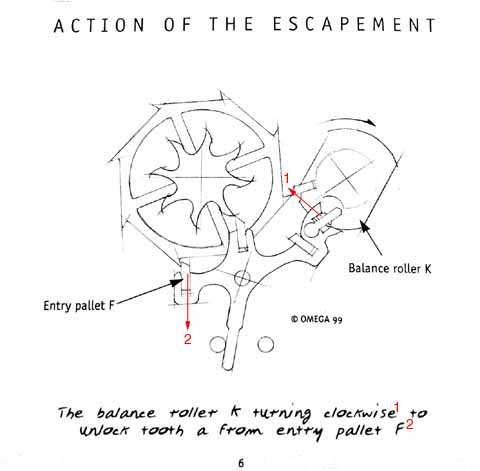
The photo above (from the Omega literature) shows the initial conditions of the escapement when the balance is rotating in a clockwise direction, with the lever locked at (F) against the lower teeth of the Co-Axial wheel. In Step 1 (marked with a red arrow labeled "1"), the balance pin (a.k.a. roller jewel) is entering the fork of the Co-Axial lever. As it continues to rotate clockwise, the lever assembly will be moved counterclockwise, which will release the entry pallet (F) from the lower teeth of the Co-Axial wheel (Step 2). This frees the Co-Axial wheel to unwind (always counterclockwise), and results in the following action (picture from the Omega literature):

Once the lever has been unlocked, the extra jewel on the balance
itself (J) is now in position to take an impulse from the lower
teeth of the Co-Axial wheel directly (marked in red). This
will provide energy to the balance to keep the amplitude high,
and simultaneously will also rotate the lever through to the locked
position via the action of the balance pin.
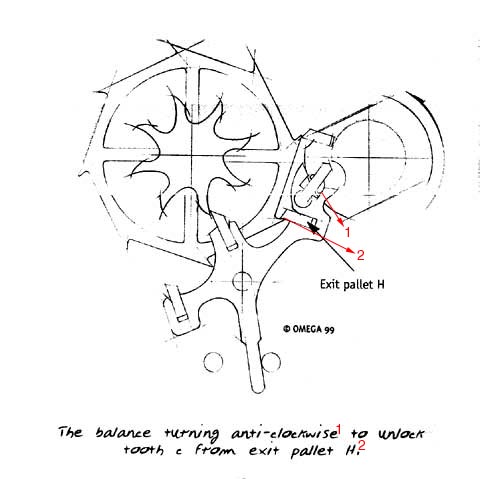
This photo (from Omega literature) shows the initial, locked condition of the escapement as the balance wheel rotates counterclockwise. The balance pin enters the lever's fork, thus rotating the lever assembly clockwise (Step 1 in red). As the lever assembly rotates clockwise, the exit pallet jewel (H) is pulled out of contact from the lower teeth of the Co-Axial wheel (Step 2). This frees the Co-Axial wheel to unwind again, yielding the following action (from Omega literature):
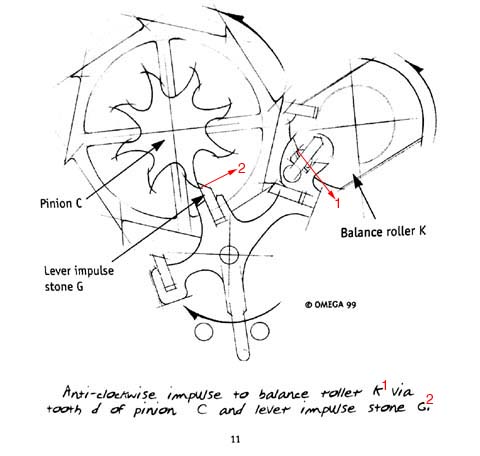
Impulse jewel (G) is now in a position to receive an impulse from the upper Co-Axial wheel (marked 2 to be consistent with the caption). This force is transmitted through the lever to the balance pin in the fork of the lever (marked 1 to be consistent with the caption), which will keep the balance moving. The lever will also be pulled through so that the escapement is locked once again after the balance pin leaves the lever fork.
Note the counter clockwise escapement action differs from the clockwise escapement action: here the impulse is transmitted indirectly via the lever. In the clockwise case, the balance receives the impulse directly from the Co-Axial wheel. However, due to the design of the lever assembly, the force transmitted in either case is similar.
Finally, for more information regarding the Daniels escapement,
with photos from some of George Daniel's handmade prototypes,
I'll point you toward Gerry
Luppino's TZ Classic on the subject.

The other significant design feature of the Caliber 2500, separate from the Co-Axial escapement, is the introduction of Omega's Free Sprung Balance system. This is a regulator-less system similar to the Patek Gyromax and Rolex Microstella system. The absence of a regulator leads to better position performance, as there are no regulator pins to affect the action of the hairspring as it coils and uncoils. (Note there is a fourth spoke to the wheel, it just didn't come out in the scan.)
To control the rate of the watch, two microscrews are embedded into the rim of the balance. These are adjusted as a pair using a special tool calibrated to give precise advancement or retardation of rate.
Other than these two features, the remainder of the movement appears to be a standard Omega 1120, with possibly some modifications to the wheel train gear ratios to accomodate the new escapement.
Since acquisition in November, the daily rate of the watch has been truly outstanding. The overall rate appears to be slightly slow when kept partially wound on a winder (less than 1 second per day), but runs slightly fast when worn on my wrist (your mileage may vary, of course). The net result is that I have not had to reset this watch for well over a month, and it has stayed within 10 seconds of radio-controlled clock time (even during a ten day stretch on the winder).
Since the Free Sprung balance and the Co-Axial escapement should
both work to improve the overall performance, I cannot attribute
the accuracy to one or the other. Regardless, the combination
of the two appears to work well.

The finishing of the case is truly outstanding, comparable to the two JLC's in my collection for smoothness and mirror sheen of the polished surfaces. Omega did not spare any expense on getting the case right. (Note - the color balance is a bit off on the following close-ups. The color in the above photo is correct.)
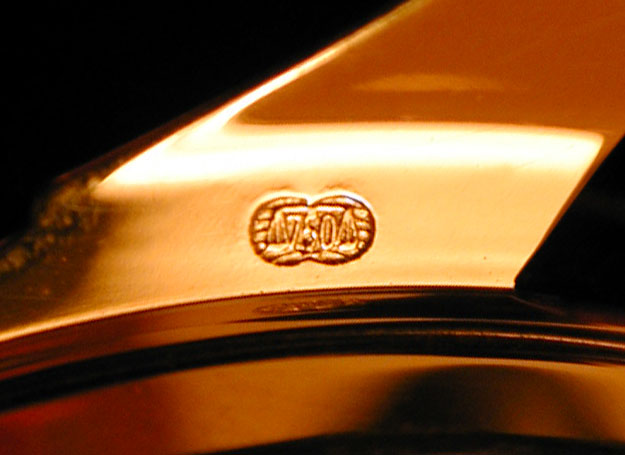
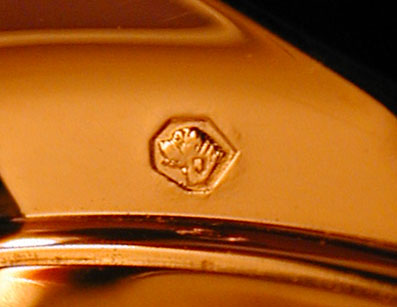

The crown is embossed with the Omega logo, and does not screw down. It is protected by two horns, and is of sufficient size and shape to allow comfortable manual winding and setting. The winding and setting itself has a standard ETA feel to it, nothing special.
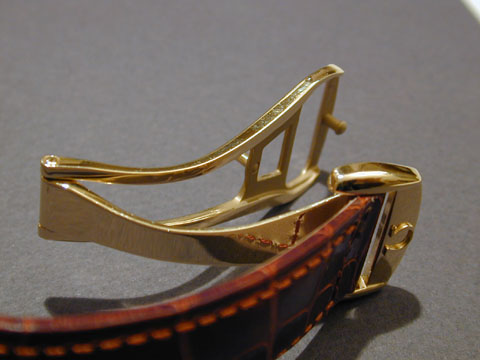
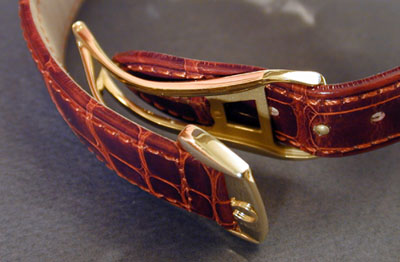
The watch comes with a first-quality padded crocodile strap,
in a rich medium brown which complements the yellow gold perfectly.
The deployant clasp is also 18k yellow gold and it differs from
the usual clasp in having two pins to grasp holes in the strap.
Note that the free end of the strap is folded under the buckle,
rather than the usual through-the-buckle design. The clasp
itself is very firm, with a good tactile feel to closing, and
doesn't show any tendency to open on its own. Well thought
out, and well executed.
The dial on this watch, which lies under a flat sapphire crystal, is really something special. The surface of the white dialed version is finely textured, which yields a slight opalescence to the appearance. It is also pie-panned and quite thick, as the following close-up illustrates:
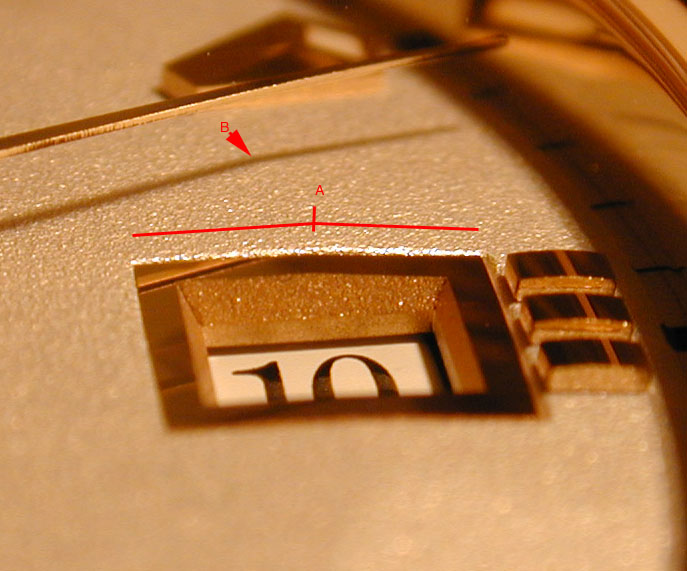
Note the pie-panning, visible as a bevel in the date window (A), and as a bend in the shadow of the second hand (B). Note also the fine polish given to the hour markers and the inside of the case band. This highly reflective inside is actually put to good use as shown below:
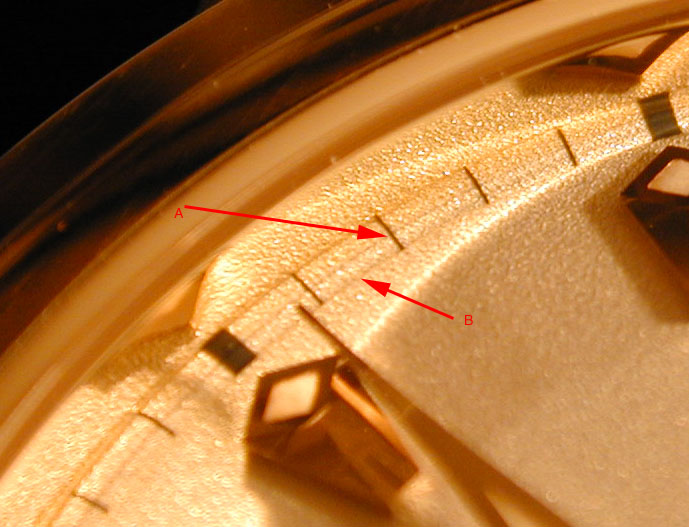
This close-up of the dial edge reveals two interesting design
features. First, the printed minute markers are actually
only half as long as they appear! The appearance of the
full length is given by the combination of the marker itself and
its entire reflection in the inner case band surface (A).
Second, there is a vertical step to the dial right at the edge
before the minute markers (B). This gives an appearance
of a finely printed circular track where none actually exists.
(You can also see the non-tritium luminous diamond-shaped areas
in the polyhedral hour markers in this photo).
This is the first watch that I've collected for a particular purpose beyond the visible - that is, the Co-Axial movement hidden behind the solid back.
Some may argue that the Co-Axial escapement is wasted on an ETA 2892 based movement. I'll disagree somewhat, only because the escapement is the single most important piece of any watch. Rather than develop an entirely new automatic winding system and wheel train, Omega took the conservative step in releasing it within a time tested and reliable architecture. While purists may disagree, Omega chose to ensure that the world premier of the Co-Axial escapement would NOT be hindered by unrelated development problems elsewhere in the movement. This, to some extent, reduces the risk involved with introducing a radical (by horological standards) new technology.
In any case, I'm very pleased with the watch. It has great styling of the dial and case, and is priced reasonably for a substantial gold watch even at full retail. The fact that it has the initial serial production run of a new escapement, and is also a limited edition is icing on the cake.
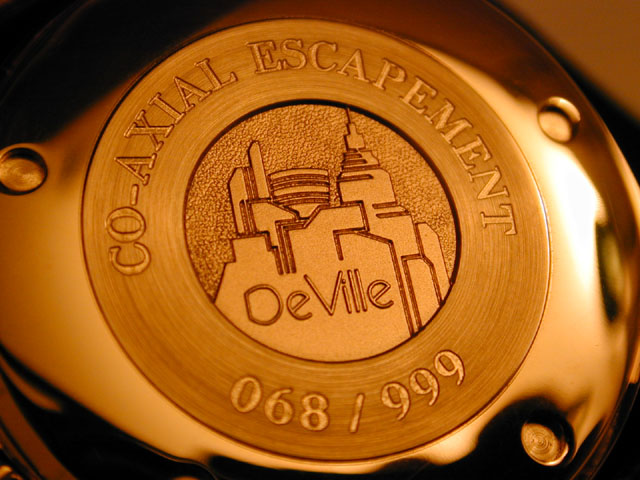
About the photographs in this article: I used a Nikon Coolpix 950, with a tripod on a desktop. For many of the images, a light tent made of a white diffusion filter was placed over the watch, using a dark grey textured cardboard background. No flash was used; instead, a combination of direct and indirect halogen and regular incandescent lighting was used. Note that many of the photos have been resampled to half size using Adobe Photoshop 4.5.